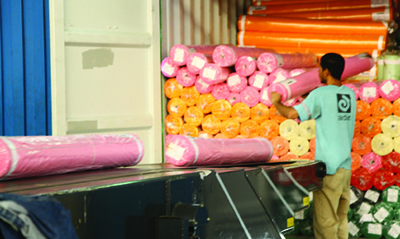In the past, ADAR, a textile supplier based in Brazil, only unloaded rolls and bales of cloth manually. And, 120 people usually worked on three lines, which operated 24 hours a day, as 2,000 to 4,000 rolls of textile were unloaded from each container.
The rolls were palletized and then moved to checking stations, where each roll was verified against the delivery note. Afterward, the rolls were wrapped and transported to the loading area. Once dispatched—the turnaround time was typically three days—the customer could be invoiced for the goods.
Now, unloading, sorting, wrapping and dispatch is one cohesive, in-line process. A customer’s order can be invoiced just hours after the container arrives at the unloading area, while a cycle time analysis can also identify the unloading process’s bottlenecks, generally palletizing and wrapping.
Before investing in telescopic belt conveyors, ADAR was still interested in automation, stipulating that all elements of the system must be able to handle rolls weighing between 5 and 70 kilograms.
Even if totally extended, telescopic belt conveyors can easily handle such loads, and they are used to unload roughly 15,000 to 20,000 rolls each day from 20 (or more) containers—a substantial increase on the previous capacity of eight containers a day.
And, on the loading side of the operation, telescopic belt conveyors are also used at four doors to load approximately 30 trailers each day, corresponding to more than 30,000 rolls.
The cost of hiring 3PL companies to unload containers has been exorbitant, due to the size and weight of the cargo involved. As part of the optimization project, ADAR decided to move this process in-house. And, although labor is readily available in Brazil and because manpower costs are seldom considered, ADAR expected the new system to prove beneficial in this respect, too.
Telescopic belt conveyors, which improve the ergonomics of loading and unloading, have resulted in a significant reduction in costs related to employee sickness. And, the need to hire external workers has also been completely eliminated.
Caljan Rite-Hite
(414) 355-2600
Article topics








